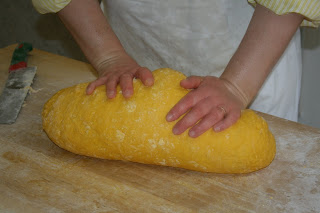Of all the Colli Bolognese producers, Lambertini has established a global toehold with his Bonzarone, an oak aged cabernet sauvignon that scored 94 out of 100 in a Wine Spectator review. In fact, it’s one of the only two Colli Bolognesi producers recognised by the respected US magazine, the other being Lambertini’s neighbour, Vallania. We taste a young barbera still in barrel, a new venture for the vineyard. There’s none of the thinness and sharpness I’m afraid I associate with this grape. Not a classic maybe but with the prospect of being on a par with many

Checking the labels – a gift for quality
a wine from Piedmont, the traditional home of barbera - although nobody outside Italy will ever know it unless something is done to improve the marketing of Colli Bolognesi.
a wine from Piedmont, the traditional home of barbera - although nobody outside Italy will ever know it unless something is done to improve the marketing of Colli Bolognesi.
It is a sad fact that the best wine growing region(s) does not coincide with the best food region in Italy. But wines from the Bolognese hills deserve better than to be totally unknown outside Italy - unless you count Lambrusco.
 Tenuta Bonzara’s sparkling wine ready for packaging
Tenuta Bonzara’s sparkling wine ready for packagingMario, the cantina manager, is determined to show off his best. Marcello thinks that the sauvignon blanc is ‘terrific’. The nose is powerful with fruit, like a southern hemisphere wine, and it has a great finish, like a French wine. I try pignoletto, a personal favourite. Light and subtle, it makes a perfect aperitif, especially in the frizzante (petillant) style.
We cannot escape without a tour of the vineyard. We hurtle down the hillside in Mario’s well-used Fiat Panda to the point where old vines and new vines meet. The new ones are planted much closer together, 80centimetres instead of 1.5 metres; the theory is that denser planting produces better grapes and less foliage. Quality is the mantra of the best producers like Lambertini but Italy is still the world’s biggest bulk exporter.
 Mario and Marcello compare grape varieties
Mario and Marcello compare grape varietiesOn a fine day, you can see for yourself. Book into the Trattoria San Chierlo for lunch and then visit the Cantina at Tenuta Bonzara, a hundred metres away.
Trattoria di San Chierlo
Via S. Chierlo, 13/A -
40050 Monte San Pietro (BO)
Tel +39 051.6768270 -
Email: info@trattoriasanchierlo.it
Tenuta Bonzara
http://www.bonzara.com/eng/trattoria_bologna.php










